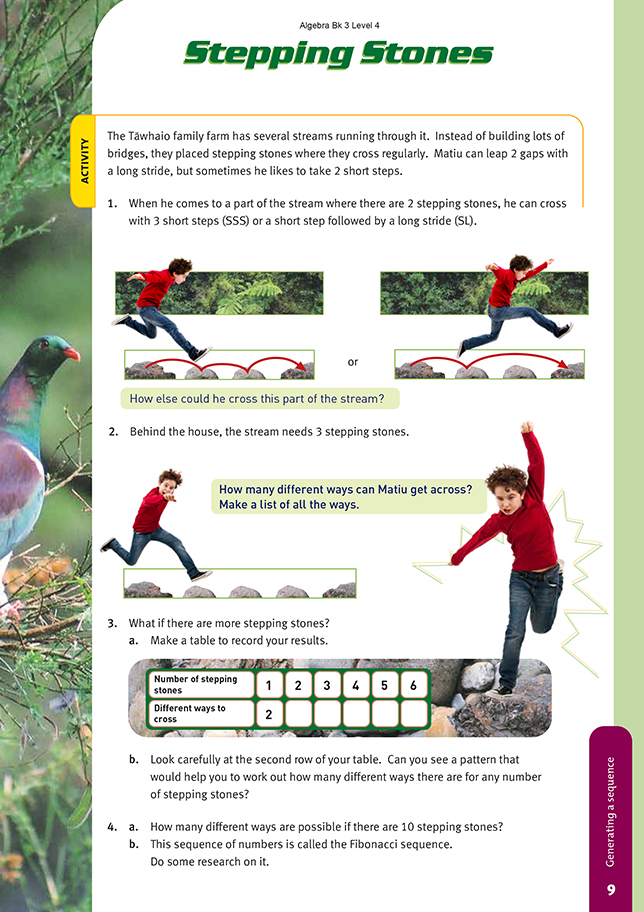This is a level 4 algebra strand activity from the Figure It Out series.
A PDF of the student activity is included.
Click on the image to enlarge it. Click again to close. Download PDF (291 KB)
use a table to describe a pattern
FIO, Level 4, Algebra, Book Three, Stepping Stones, page 9
In this activity, students must work systematically to investigate the different ways that the stream can be crossed when there are 0, 1, 2, 3, 4, … stepping stones. The number sequence, 1, 2, 3, 5, 8, 13, 21, 34, 55, 89, 144, 233, … that emerges is known as the Fibonacci sequence, where each number is the sum of the two preceding numbers. There is no simple way of applying this as a rule for a particular stepping stone, but the students should be able to spot the pattern.
When the students have found the pattern (question 4) that gives the number of ways a stream with n stepping stones may be crossed, encourage them to think about why the pattern works.
The 4-stepping-stone case is considered in the diagram below (the same argument can be applied to any other number of stones).
.gif)
In order to get to the far side, the last step must be either a long step from stone 3 or a short step from stone 4 (these are the only options). There are 3 ways to get to stone 3, so there are 3 ways to get to the far side via a long step from stone 3. There are 5 ways to get to stone 4, so there are 5 ways to get to the far side via a short step from stone 4. Because these are all the ways to get to the far side, there is a total
of 3 + 5 = 8 ways to cross a stream with 4 stones.
Note that the number of ways (3) to get to the third stone is the same as the number of ways to cross a stream with 2 stones. Similarly, the number of ways (5) to get to the fourth stone is the same as the number of ways to cross a stream with 3 stones.
Leonardo Fibonacci’s number sequence appeared as a solution to a problem in his book Liber Abacci, which was based on the arithmetic and algebra that Fibonacci accumulated during his many travels in Europe and North Africa.
The problem and its solution are as follows.
A certain man put a pair of rabbits in a place surrounded on all sides by a wall. How many pairs of rabbits can be produced from that pair in a year if it is supposed that every month each pair begets a new pair that from the second month on becomes productive?
Students who are familiar with rabbits may query the productivity at 2 months, the lack of any deaths, and the licence taken in assuming that female rabbits always give birth to a single male/female pair.
However, the gestation period (the time carried in its mother’s womb) for rabbits is accurately given as 30 days (1 month), and the problem is still valid in terms of the mathematics involved. A solution to this original Fibonacci problem is shown in the following table.
.gif)
The number of pairs of rabbits after any month is the sum of the pairs of rabbits at the end of the 2 preceding months. So, after 5 months, there are 3 + 5 = 8 pairs of rabbits, after 6 months there are 5 + 8 = 13 pairs of rabbits, after 12 months, there are 89 + 144 = 233 pairs of rabbits, and so on.
Answers to Activity
1. Long stride, short step (LS)
2. Matiu can cross the stream in 5 different ways:
SSSS; LL; SSL; SLS; LSS
3. a.
.gif)
b. Each number in the second row of the table is the sum of the two preceding numbers. (The next three numbers in the table would be 34, 55, and 89. They are part of the Fibonacci sequence mentioned in question 4b.)
4. a. 144. (55 + 89, the two preceding numbers)
b. Leonardo Fibonacci (1170–1240) was an Italian mathematician. His major work was the book Liber Abacci, published in 1202. He is best remembered for the solution to a problem related to rabbit reproduction. His solution led to the
Fibonacci number sequence, 1, 1, 2, 3, 5, 8 …, where each number in the sequence is the sum of the two preceding numbers.
